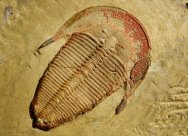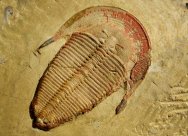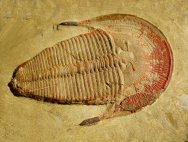Harpides cf grimmi
(Barrande, 1872)
Trilobite Order Harpetida, Suborder Harpetina, Superfamily Harpetioidea, Family Harpetidae
Geologic Time: Lower Ordovician
Size: Trilobite is 62 mm long
Fossil Site: Lower Fezouata Formation, Dra Valley, Morocco
Trilobite Order Harpetida was not erected until 2002, when it was split off from Order Ptychopariida in which it was Suborder Harpina. Harpetids are now mostly considered to be descended from the Ptychopariids sometime in the middle Cambrian. Harpetida is the least diverse of all the trilobite orders by a wide margin, with but three families represented. At the trilobite order level, the Harpetids are generally also the rarest. This beautiful trilobite comes from the Lower Ordovician Fezouata Formation of Morocco. Trilobites from this site only emerged after collecting commenced in 2010. The site is noted for preservation in browns and shades of red due to diagenesis processes during sedimentary rock formation. Fossils from the site also vary in surface texture from fairly smooth to that of coarse sandpaper, with the smoother fossils retaining more fine details. This particular specimen exhibits superior preservation for the Fezouata Formation, as seen in the very fine details and articulation of both the cephalon and pygidium. Note how wide is the cephalon brim that contained the ports for its filter feeding lifestyle. Also not its small pygidium. |



